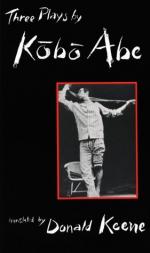|
This section contains 546 words (approx. 2 pages at 300 words per page) |

|
SOURCE: “Sand and Tendrils.” The Economist 320, no. 7718 (3 August 1991): 82.
In the following essay, the reviewer provides a positive assessment of Beyond the Curve.
“This is the story of how Common became a dendrocacalia.” So runs the opening line of a short story in which Kobo Abe, perhaps Japan's most renowned novelist, turns a man who is tired of city life into a plant. It can now be read in English in a collection of Mr Abe's short stories, Beyond the Curve, published by Kodansha International. The collection shows Mr Abe at his best, full of wry humour and images of self-defeat, and obsessed with the idea that alienation is the natural condition of contemporary man.
“Dendrocacalia” was written in 1949, when Mr Abe was 25. In these early stories and in many of the novels that were to follow, human relations are a minefield of treachery, humiliation, and love avoided. Man...
|
This section contains 546 words (approx. 2 pages at 300 words per page) |

|


